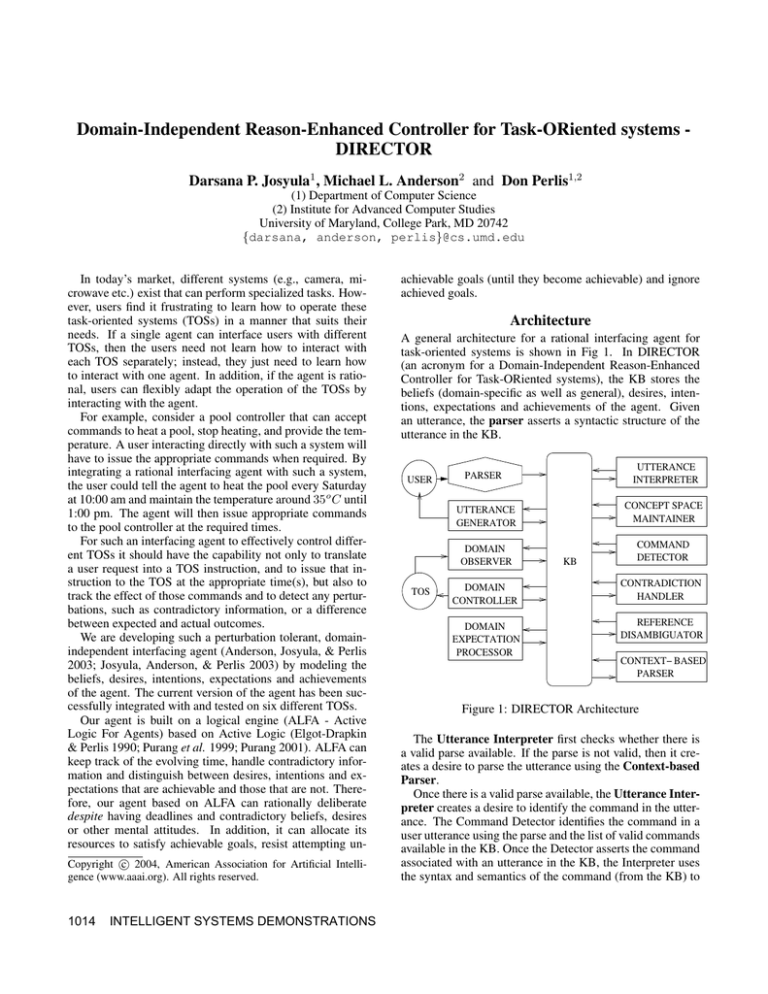
Domain-Independent Reason-Enhanced Controller for Task-ORiented systems DIRECTOR
Darsana P. Josyula1 , Michael L. Anderson2 and Don Perlis1,2
(1) Department of Computer Science
(2) Institute for Advanced Computer Studies
University of Maryland, College Park, MD 20742
{darsana, anderson, perlis}@cs.umd.edu
In today’s market, different systems (e.g., camera, microwave etc.) exist that can perform specialized tasks. However, users find it frustrating to learn how to operate these
task-oriented systems (TOSs) in a manner that suits their
needs. If a single agent can interface users with different
TOSs, then the users need not learn how to interact with
each TOS separately; instead, they just need to learn how
to interact with one agent. In addition, if the agent is rational, users can flexibly adapt the operation of the TOSs by
interacting with the agent.
For example, consider a pool controller that can accept
commands to heat a pool, stop heating, and provide the temperature. A user interacting directly with such a system will
have to issue the appropriate commands when required. By
integrating a rational interfacing agent with such a system,
the user could tell the agent to heat the pool every Saturday
at 10:00 am and maintain the temperature around 35o C until
1:00 pm. The agent will then issue appropriate commands
to the pool controller at the required times.
For such an interfacing agent to effectively control different TOSs it should have the capability not only to translate
a user request into a TOS instruction, and to issue that instruction to the TOS at the appropriate time(s), but also to
track the effect of those commands and to detect any perturbations, such as contradictory information, or a difference
between expected and actual outcomes.
We are developing such a perturbation tolerant, domainindependent interfacing agent (Anderson, Josyula, & Perlis
2003; Josyula, Anderson, & Perlis 2003) by modeling the
beliefs, desires, intentions, expectations and achievements
of the agent. The current version of the agent has been successfully integrated with and tested on six different TOSs.
Our agent is built on a logical engine (ALFA - Active
Logic For Agents) based on Active Logic (Elgot-Drapkin
& Perlis 1990; Purang et al. 1999; Purang 2001). ALFA can
keep track of the evolving time, handle contradictory information and distinguish between desires, intentions and expectations that are achievable and those that are not. Therefore, our agent based on ALFA can rationally deliberate
despite having deadlines and contradictory beliefs, desires
or other mental attitudes. In addition, it can allocate its
resources to satisfy achievable goals, resist attempting unc 2004, American Association for Artificial IntelliCopyright gence (www.aaai.org). All rights reserved.
1014
INTELLIGENT SYSTEMS DEMONSTRATIONS
achievable goals (until they become achievable) and ignore
achieved goals.
Architecture
A general architecture for a rational interfacing agent for
task-oriented systems is shown in Fig 1. In DIRECTOR
(an acronym for a Domain-Independent Reason-Enhanced
Controller for Task-ORiented systems), the KB stores the
beliefs (domain-specific as well as general), desires, intentions, expectations and achievements of the agent. Given
an utterance, the parser asserts a syntactic structure of the
utterance in the KB.
USER
PARSER
UTTERANCE
INTERPRETER
UTTERANCE
GENERATOR
CONCEPT SPACE
MAINTAINER
DOMAIN
OBSERVER
TOS
KB
COMMAND
DETECTOR
DOMAIN
CONTROLLER
CONTRADICTION
HANDLER
DOMAIN
EXPECTATION
PROCESSOR
REFERENCE
DISAMBIGUATOR
CONTEXT− BASED
PARSER
Figure 1: DIRECTOR Architecture
The Utterance Interpreter first checks whether there is
a valid parse available. If the parse is not valid, then it creates a desire to parse the utterance using the Context-based
Parser.
Once there is a valid parse available, the Utterance Interpreter creates a desire to identify the command in the utterance. The Command Detector identifies the command in a
user utterance using the parse and the list of valid commands
available in the KB. Once the Detector asserts the command
associated with an utterance in the KB, the Interpreter uses
the syntax and semantics of the command (from the KB) to
determine the objects associated with the command. In case,
the object references in the utterance parse are ambiguous,
the interpreter creates a desire to determine the referents for
the ambiguous object references.
For each ambiguous object reference, the Reference Disambiguator first introspects to determine whether the reference can be disambiguated using the current contents of
the KB. If introspection does not resolve the referent, then
the Disambiguator creates a desire to get help from either
the user or the TOS. For instance, for the ambiguous expression “the Chicago train”, the Disambiguator first introspects to determine the referent. If introspection fails to
identify the referent, then a desire is created to get help from
the TOS. (Thus, the agent could ask the TOS for the current train at Chicago, if it already knows that the expression
“the Chicago train” refers to the train that is currently at
Chicago.) If both introspection and interaction with the TOS
fail to provide a referent, then the Disambiguator will create
a desire to ask the user for clarification.
Utterance Generator executes the intentions of producing utterances. For questions type of utterances, an expectation about the user’s response is created and represented
in the KB. This expectation is used by the Context Based
Parser to parse user responses.
Domain Controller executes the intentions of sending
valid instructions to the TOS. If there is an anticipated result
(in the KB) associated with an instruction, then an expectation for that result is created in the KB, when that instruction
is issued to the TOS. Once the Domain Controller executes
an intention, it creates a desire to inform the user about the
action that it is taking.
For each expectation that the Domain Controller produces, the Domain Expectation Processor initiates an observation to confirm that expectation, if such an observation
action has not been initiated already.
While Domain Controller sends instructions to the TOS,
its counterpart - Domain Observer - receives information
from the TOS. The information about the format of the TOS
outputs and the expectations created by the Domain Controller are used to interpret the observations that the Domain
Observer receives.
The Concept Space Maintainer makes modifications to
the belief space of the KB. These changes include additions,
modifications and deletions; correspondingly learning, belief revision and unlearning respectively is achieved. Once
the Concept Space Maintainer executes an intention, it creates a desire to inform the user about the action that it has
taken.
When a contradiction occurs in the KB, the Contradiction Handler notes the contradiction and tries to resolve the
contradiction. How the contradiction is resolved depends on
the type of contradiction. When enough information is not
available to fix an inconsistency, the contradiction handler
will create a desire to get help from the user to fix the inconsistency.
Implementation
We have implemented the DIRECTOR architecture in an
interfacing agent - ALFRED (Active Logic for Reason-
Enhanced Dialog). ALFRED interprets the user requests
and creates desires to accomplish the requests. Based on its
knowledge and availability of time and resources, it creates
and executes intentions to achieve the requests. Since ALFRED does not interact with the real world, the only way it
can determine whether an instruction that it issued to a TOS
has resulted in the desired action is by confirming it from
either the user or the TOS. In order to make this determination, ALFRED creates an expectation regarding the outcome, based on available knowledge, whenever it initiates
an action and compares the actual result with the expected
outcome.
The current version of ALFRED can translate a user request to a valid action request, for either the TOS to perform
a task or for ALFRED to update its Knowledge Base. In addition, it can learn alternative names for existing TOS commands, ALFRED commands or domain objects via user instructions. ALFRED can also interface with different TOSs
by merely changing the initial Knowledge Base.
Alfred has been tested on the following domains:
• Simulated Pool: Alfred controls the temperature settings
of a pool based on user needs.
• Movie Player: Alfred plays different movies based on
user requests.
• Toy Train: Alfred moves various trains to different cities
based on user requests.
• Simulated House: Alfred controls different appliances in
a house based on user needs.
• Home Designer: Alfred helps the user create and move
different objects in a house model.
• Chess Player: Alfred plays chess for the user by sending
the user requested moves to a chess program.
References
Anderson, M. L.; Josyula, D.; and Perlis, D. 2003. Talking
to Computers. In Proceedings of the Workshop on MixedInitiative Intelligent Systems at the Eighteenth International Joint Conference on Artificial Intelligence (IJCAI03).
Elgot-Drapkin, J., and Perlis, D. 1990. Reasoning Situated
in Time I: Basic Concepts. Journal of Experimental and
Theoretical Artificial Intelligence 2(1):75–98.
Josyula, D. P.; Anderson, M. L.; and Perlis, D. 2003.
Towards Domain-independent, Task-oriented, Conversational Adequacy. In Proceedings of the Eighteenth international Joint Conference on Artificial Intelligence (IJCAI03), 1637–1638.
Purang, K.; [Josyula], D. P.; Traum, D.; Andersen, C.; and
Perlis, D. 1999. Practical Reasoning and Plan Execution
with Active Logic. In Proceedings of the IJCAI-99 Workshop on Practical Reasoning and Rationality, 30–38.
Purang, K. 2001. Alma/Carne: Implementation of a Timesituated Meta-reasoner. In Proceedings of the Thirteenth
International Conference on Tools with Artificial Intelligence (ICTAI-01), 103–110.
INTELLIGENT SYSTEMS DEMONSTRATIONS 1015


